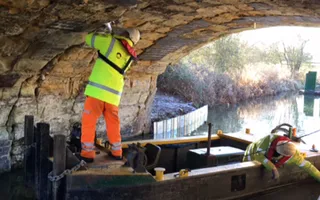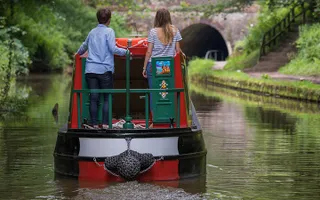These are for workboats with no overnight accommodation that are used exclusively for ‘qualifying waterway maintenance work'. This is defined as follows:
Work on waterway infrastructure, structures or development sites adjacent to the waterway under contract to the Canal & River Trust, another statutory undertaker or a private contractor, providing that the work is undertaken from or involves direct access from the craft operating on the waterway.
The boat will require a home mooring unless it is removed from the waterway when not in use. We understand that some works will take longer than 14 days, but there is no provision for leaving these craft on the waterway between jobs.
This licence does cover the removal of 'Section 8' boats from the waterway, but not private towing contracts or cargo carrying; these activities require a Roving Trading Licence. The Policy for Workboats and Cargo Carrying gives further details.
Key considerations
The boat will need to be removed from the waterway when not in use or have a permanent mooring where it can be kept.
This licence does not apply to any boat with living accommodation on board.
Regulations
A copy of the Regulations checklist for each sector can be downloaded here.
Insurance
You will need to obtain Third party and Public Liability Insurance cover provided by a company that is authorised and regulated by the Financial Conduct Authority which covers liabilities of at least two million pounds for each claim.
You must provide us with evidence that you are insured for your proposed activities on application.
Boat Safety Scheme Certificate
You will need a Boat Safety Scheme certificate. If you wish to licence an unpowered butty, hopper, dumb barge or workflat please provide a Boat Safety Scheme Exemption Declaration instead.
Boatmaster's licence
All skippers on the licensed craft must hold a valid Boatmaster's Licence (BML) or equivalent.
Boater's Handbook
We have now launched a new edition of the Boater's Handbook in partnership with the Environment Agency.
First published in 2002, the handbook is written for boat owners and hirers and contains lots of 'getting started' tips, as well as important information about how to boat safely.
The updated handbook contains some new information on waterway dimensions. There are also pointers on the extra factors owners and hirers of wide beams need to be aware of when navigating and mooring.
The Handbook was originally commissioned by British Waterways in partnership with the Environment Agency and the British Marine Federation. An expert group was commissioned to develop key messages and content, drawing on other published sources and relevant empirical evidence. Since then, there have been several re-prints which incorporated best practice updates.
Download it below, or order a free hard copy from the online shop.





